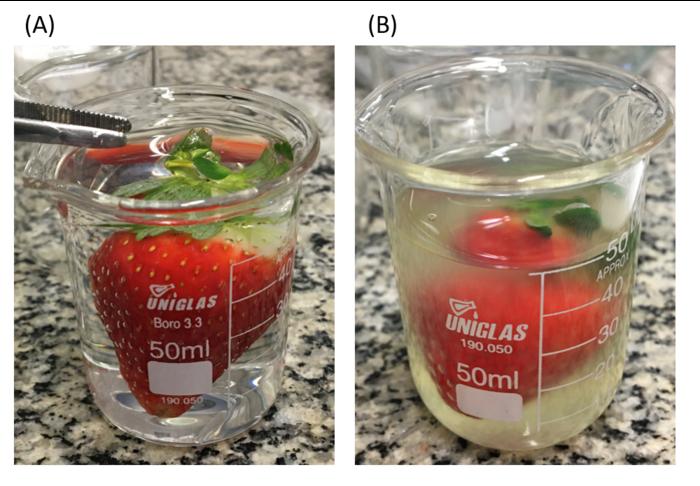Research from Brazil has led to the development of a groundbreaking edible biofilm derived from agricultural and fishery waste, which enhances the shelf life of strawberries, scientifically known as Fragaria x ananassa. Conducted by a dedicated team at the São Carlos Institute of Chemistry at the University of São Paulo, this innovation addresses the pressing issue of food spoilage and offers potential solutions for extending the marketability of these highly perishable fruits. This biofilm, created using natural materials, could redefine how we approach food preservation and waste reduction within the agricultural sector.
The researchers conducted extensive laboratory tests to assess the effectiveness of this biofilm on strawberries stored in refrigerated conditions. Remarkably, the fruit coated with this innovative film exhibited only an 11% weight loss over a span of 12 days. In contrast, uncoated strawberries began showing signs of fungal contamination after merely four days. This significant disparity highlights the film’s potential not only for extending the fruits’ freshness but also for serving as a protective barrier against spoilage and waste.
The collaborative effort received substantial backing from the São Paulo Research Foundation (FAPESP) and partnered with experts from EMBRAPA Instrumentation as well as the Federal University of São Carlos (UFSCar). Their findings were featured in a prestigious publication in the journal Food Chemistry, marking a significant milestone in food preservation research. The innovative biofilm showcases the team’s ability to harness local resources, turning what was once considered waste into a valuable asset for food preservation.
Central to the creation of this edible film is the extraction of antioxidants from pomegranate peel, a byproduct often discarded in food processing. Utilizing natural deep eutectic solvents (NADES), researchers achieved an impressive 84.2% increase in antioxidant extraction efficiency from pomegranate peels. This extraction mechanism significantly contributes to enhancing the shelf life of strawberries by infusing the biofilm with preservative properties that combat microbial growth and oxidative degradation.
The approach of utilizing pomegranate peels aligns with sustainable practices by repurposing agricultural waste into functional materials. As over 40% of a pomegranate can consist of peel, this research embraces an eco-friendlier methodology by reducing waste while simultaneously providing health benefits to consumers. The antioxidants derived from these peels not only enhance the biofilm’s functionality but also underscore the importance of exploring alternative applications for food industry byproducts.
To maximize the effectiveness of the biofilm, the research team chose to incorporate chitosan, a natural biopolymer extracted from the shells of crustaceans. Unlike chitosan derived from shrimp, which poses allergenic concerns, chitosan sourced from squid offers a safe alternative with similar beneficial properties. By combining chitosan and gelatin, the team created a robust film that could withstand different environmental conditions while ensuring the integrity of the strawberries during storage and transport.
Strawberries served as an ideal candidate for this study due to their high perishability and susceptibility to microbial attacks. Their relatively short shelf life of under a week and their high respiratory activity created a compelling case for testing this biofilm’s efficacy. Encouraged by preliminary results, researchers hypothesized that this protective film could potentially be effective on other fruits, leading to broader applications in the field of food preservation.
In testing the hypothesis, strawberries were coated through an immersion method, followed by evaluations of their physicochemical properties, microbiological safety, and sensory characteristics throughout the storage period. The treated strawberries displayed a remarkable ability to retain their texture, color, and bioactive compounds, demonstrating that the coating effectively slowed metabolic processes during the post-harvest phase. This innovative solution addresses not only the logistical challenges of fruit distribution but also the nutritional quality concerns prevalent in the industry.
The research team’s analysis showed that the edible film can successfully form a moisture-retentive barrier, preserving the fruit’s sensory qualities and preventing dehydration. Coated strawberries displayed significant improvements in maintaining weight and delaying fungal infections, ultimately contributing to enhanced market viability. Furthermore, the film’s ability to maintain the volatile compounds responsible for the fruit’s aroma highlights its positive influence on consumer preferences, supporting sensory appeal.
Remarkably, this biofilm does not alter the taste, aroma, or visual attributes of strawberries, as indicated during sensory analyses conducted with participants from the University. This further solidifies its potential application in commercial settings, where maintaining the original integrity of the fruit is crucial for customer satisfaction. As market readiness approaches, the team has filed a patent application for their formulation, ensuring that their research findings can be translated into practical solutions for industry stakeholders.
An estimated cost of BRL 0.15 per fruit has been projected for the application of this biofilm, suggesting that consumers may find the added expense reasonable for fruits with extended shelf life and enhanced usability. As food waste continues to present a growing concern worldwide, this innovation offers a progressive step towards tackling perishability issues while promoting sustainability within the agricultural domain.
In conclusion, the development of this edible biofilm signifies a pivotal breakthrough in food preservation technology. By leveraging waste materials and innovative techniques, researchers have paved the way for a more sustainable approach to maintaining the quality of perishable produce. As practical applications of their research emerge and the technology becomes available to interested companies, the potential impact on the agricultural industry and consumer habits could be profound.
Subject of Research: Edible biofilm for extending strawberry shelf life
Article Title: Improvement of the physical-chemical, microbiological, volatiles and sensory quality of strawberries covered with chitosan/gelatin/pomegranate peel extract-based coatings
News Publication Date: 2-Jan-2025
Web References: https://www.sciencedirect.com/science/article/abs/pii/S0308814625000056
References: Online journal publication in Food Chemistry
Image Credits: Mirella Romanelli Vicente Bertolo
Keywords
Food preservation, Edible biofilm, Strawberries, Antioxidants, Chitosan, Pomegranate, Sustainable agriculture, Food chemistry, Waste reduction, Microbial contamination, Shelf life extension, Agricultural research.




